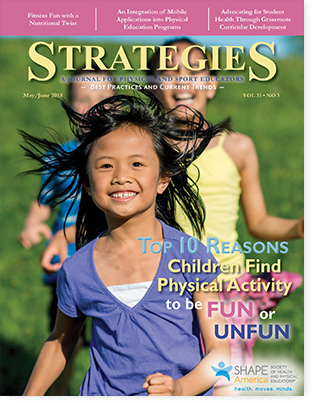 Strategies Table of Contents
Strategies Table of Contents
Top 10 Reasons Why Children Find Physical Activity to Be Fun
Christine J. Hopple

If one were to survey 100 elementary physical education teachers and coaches for the top three reasons they think children stay active and interested in physical activity, chances are that “fun” would make the majority (if not all!) of their lists. Results from research conducted with youth (as well as from teachers’ practical knowledge) has revealed that fun or enjoyment (i.e., positive affective responses encompassing feelings such as pleasure and liking; Scanlan & Lewthwaite, 1986) is a critical “must-have” if physical educators want children to voluntarily engage in physical activity (Woods, Graber, & Bolton, 2009). Conversely, it is also known (again, from both research and practical perspectives) that a lack of fun is one of the main reasons why children elect to opt out of physical activity (Crane & Temple, 2015; Visek et al., 2015).
Despite the important role that fun plays in children’s activity participation, it remains a relatively unknown and elusive entity. That is, given how many times children say, “Wow, that was fun!” after playing an activity, educators do not know exactly what that means. Does it mean that each child thinks about that activity as being fun in the exact same way and for the exact same reasons? Or if children were to play that same activity in a different setting — for example, in an organized youth activity setting instead of on the playground for recreation — would they still consider the activity to be just as fun? Do factors such as skill level make a difference in whether children view the activity as fun? And what about when the activity is not enjoyable for children? Questions such as these and others are reminders that increasing understanding about fun in physical activity, from a child’s perspective, is a worthy endeavor (McCarthy & Jones, 2007).
To determine answers to these questions, more than 90 boys and girls in grades 4, 5, and 6 from three nontraditional public schools in a midsized Mid-Atlantic community took part in surveys and interviews. First, all children completed a survey that included open-ended and Likert scale questions relative to their enjoyment of physical activity in the three activity settings of physical education, recreation and organized youth activity/sport. All children also drew a picture of “the first thing [they] think of when [they] think of physical activity.” Then, select children were chosen to be interviewed in a focus group (4 to 5 students together; 28 children total) and/or a duo interview (2 students together; 26 children total). Because obtaining the
perspectives of children of differing skill levels was desirable, children were assigned to one of three groups (low, medium, or high skill) according to their self-ratings of overall skill level. Based on these ratings and whenever possible, the same number of children in the lower- and higher-skilled groups were included in interviews, and children of the same skill level were assigned to the same interview group. Once collected, all data were analyzed according to standard research practices (please see Hopple, 2015, for a detailed description of the complete study’s methodology).
To read the rest of this article,
click here to download a pdf.